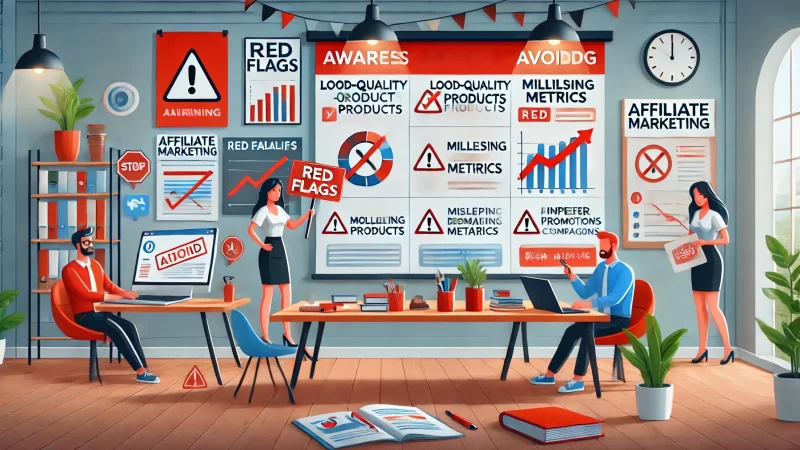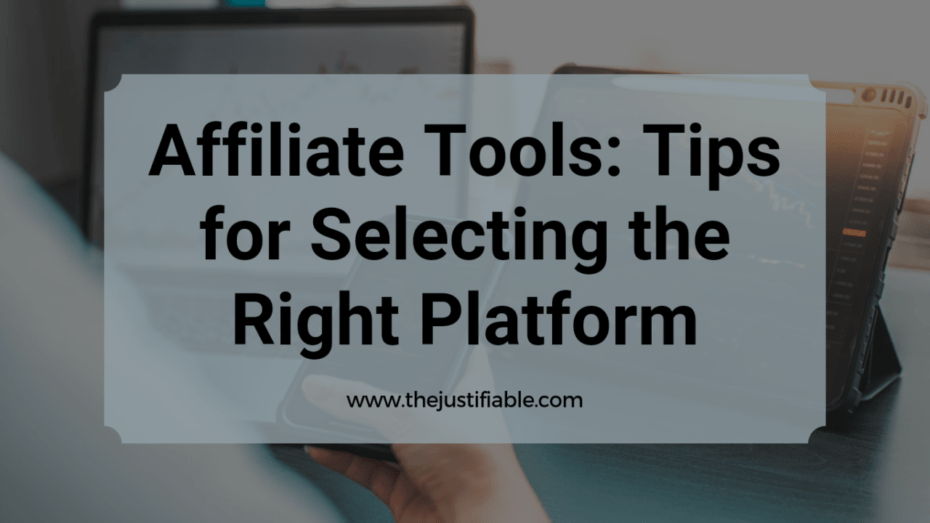Are you curious about how to make money online through affiliate marketing? Looking for proven strategies that generate income reliably?
In this guide, we’ll explore actionable methods, tips, and techniques to succeed in affiliate marketing. Whether you’re a beginner or seeking to scale your earnings, you’ll discover practical insights for achieving success.
Start With Affiliate Marketing Basics And Platforms
Understanding how to make money online through affiliate marketing begins with mastering its foundation. From grasping its principles to selecting the right tools, a strong start ensures long-term success in this rewarding field.
What Is Affiliate Marketing And How It Works
Affiliate marketing is a process where you promote a company’s products or services and earn a commission for each sale made through your unique affiliate link. I believe it’s an excellent option for those seeking a flexible income stream.
One of the best aspects is how it allows anyone to get started. By joining an affiliate program, you gain access to promotional materials to share across platforms. The better your marketing, the more you can earn.
To succeed, I recommend understanding the customer journey. This means knowing what your audience needs and presenting solutions in a relatable way. It’s about building trust while subtly integrating your affiliate promotions.
Keep in mind that consistency matters. The more effort you put into learning and applying affiliate marketing principles, the sooner you’ll see tangible results. The key is to stay committed and keep improving.
Top Platforms To Launch Your Affiliate Marketing Journey
Selecting the right platforms is critical for success. I recommend focusing on those with robust features and a reputation for reliability. Popular options like Amazon Associates and ShareASale are fantastic starting points for newcomers.
Amazon Associates is beginner-friendly, offering products in nearly every category imaginable. I find this platform ideal for those exploring general niches like home goods, electronics, or books. It’s also a great way to understand consumer behavior.
For digital goods or subscription services, consider platforms like ClickBank or CJ Affiliate. They provide higher commission rates and a variety of products, catering to audiences interested in software, courses, or memberships.
Specialized platforms like Rakuten are excellent for experienced marketers targeting niche audiences. I suggest diving into these once you’re confident with broader affiliate marketing strategies.
Whichever platform you choose, ensure it aligns with your goals. Research is your best ally here—find out what works best for your audience and your expertise.
Choosing Profitable Niches That Drive Earnings
Finding the right niche makes all the difference. I always advise focusing on topics you’re passionate about. This way, you’ll create authentic, engaging content that resonates with your audience.
Health, fitness, and personal finance are evergreen niches that continue to perform well. People constantly search for solutions in these areas, making them reliable choices for affiliate marketers.
To narrow your focus, look for sub-niches. For example, instead of “fitness,” consider “home workout equipment for beginners.” This approach helps you target a specific audience, increasing the likelihood of conversions.
I also suggest leveraging tools like Google Trends or keyword research tools to identify trending topics. Staying current ensures your content stays relevant and in demand.
Remember, a profitable niche combines personal interest with market demand. If you love what you do, success becomes more achievable and enjoyable.
Understanding Affiliate Terms And Conditions
Every affiliate program has unique terms you must follow. I can’t stress enough how important it is to read and understand these guidelines before signing up.
Common terms include minimum payout thresholds, cookie duration, and promotional restrictions. For instance, some programs might prohibit email campaigns or specific advertising tactics.
Compliance isn’t just about following rules—it’s about protecting your credibility. Violating terms could lead to penalties, including being removed from the program. I suggest maintaining a record of terms for each program you join.
Transparency matters too. Always disclose your affiliate relationship in your content. This builds trust and ensures you’re aligned with legal standards like the FTC’s guidelines.
By understanding the rules upfront, you can confidently promote products while safeguarding your reputation and earnings potential.
Choose High-Converting Products And Services

Choosing the right products is the cornerstone of how to make money online through affiliate marketing. I always say that promoting items you believe in increases your chances of success and builds trust with your audience.
Identifying Products That Solve Real Problems
People are always searching for solutions. I recommend identifying products that address common pain points or fulfill specific needs. These tend to convert better because they provide tangible value.
One way to find such products is by listening to your audience. Pay attention to their questions and challenges. If you can recommend something that truly helps, they’ll trust your suggestions.
Another strategy is to focus on products you personally use and love. Sharing firsthand experiences adds authenticity, making it easier to convince others to try them.
Don’t forget reviews and testimonials. Checking what others say about a product gives you insights into its quality and potential for success in affiliate marketing.
Building trust is easier when you’re promoting reliable, high-quality products. It’s a win-win for you and your audience.
Tools To Research Trending Affiliate Products
Finding trending products is easier with the right tools. I suggest starting with platforms like Google Trends or keyword research tools to spot what’s gaining popularity.
Another great option is affiliate marketplaces like ClickBank or Amazon. They often have sections highlighting top-performing products. This is a goldmine for discovering trends.
Social media platforms are also invaluable. Hashtags, influencer promotions, and viral content often hint at emerging products worth exploring.
By combining these tools, you can stay ahead of trends and offer fresh, in-demand products to your audience. This keeps your content relevant and engaging.
Evaluating Commission Rates And Payout Models
Not all affiliate programs are created equal. I always recommend looking at commission rates and payout structures to maximize your earnings.
High-ticket items often have higher commissions, but they may sell less frequently. On the other hand, lower-cost items might sell more consistently but yield smaller profits per sale.
Understanding cookie duration is also essential. Programs with longer cookie windows give you more time to earn commissions after a user clicks your link.
Ultimately, balance is key. Diversify your promotions with products offering varying payout models for steady and lucrative income streams.
Building Trust Through Ethical Product Recommendations
Trust is the foundation of successful affiliate marketing. I strongly believe that being honest and transparent with your audience is non-negotiable.
Always disclose your affiliate relationships. This simple step fosters trust and ensures compliance with legal guidelines.
When recommending products, focus on their benefits and potential drawbacks. This balanced approach demonstrates integrity and helps readers make informed decisions.
Finally, stay consistent with your brand values. Promoting products you genuinely believe in ensures long-term success and audience loyalty. Trust me, authenticity always wins.
Build A High-Traffic Affiliate Website Or Blog
Creating a successful affiliate website or blog is crucial for long-term success in affiliate marketing. I suggest focusing on a specific niche, optimizing for search engines, and creating valuable content that keeps your audience engaged and coming back.
Why A Niche Blog Is Key To Affiliate Success
A niche blog allows you to target a specific audience, making it easier to connect with readers and convert them into loyal customers. I believe focusing on one topic showcases your expertise and builds trust with your audience.
Choosing a niche also simplifies content creation. Writing about a subject you’re passionate about keeps your blog authentic and engaging. When you enjoy what you do, it reflects in the quality of your posts.
A targeted approach improves search engine rankings too. Search engines favor niche sites because they provide specialized knowledge. This makes it easier for potential customers to find your content.
I recommend researching popular niches that align with your interests. Look for areas with high demand but manageable competition, as this balance boosts your chances of success.
Steps To Create An SEO-Optimized Blog For Free Traffic
Building an SEO-optimized blog starts with choosing the right domain name. I advise picking a name that reflects your niche and is easy to remember. This small detail has a big impact on branding.
Next, focus on creating valuable, keyword-rich content. While SEO is important, I suggest prioritizing readability and audience engagement over keyword density. People first, search engines second.
Don’t underestimate the power of a clean website design. A user-friendly layout encourages visitors to explore your site longer, which signals search engines that your content is valuable.
Consistency is key. Posting regularly keeps your audience engaged and search engines interested. I always say that even small, consistent steps lead to big results over time.
Essential Plugins To Improve Affiliate Website Performance
Plugins are essential tools that can enhance your blog’s performance. I recommend starting with plugins like Yoast SEO for optimizing content and All-in-One WP Security for safeguarding your site.
For affiliate marketing, consider using Pretty Links. It simplifies managing affiliate links, making them cleaner and easier to track. I personally find it invaluable for organizing campaigns.
Adding caching plugins like Litespeed Cache improves site speed. Faster websites not only enhance user experience but also rank better on search engines, helping you attract more visitors.
Another plugin worth exploring is MonsterInsights, which integrates Google Analytics. I believe understanding your traffic sources and audience behavior is crucial for refining your affiliate strategies.
Strategies To Create Engaging Content That Converts
Content is king, but engaging content reigns supreme. I recommend focusing on solving problems and addressing your audience’s pain points directly in your posts.
Storytelling works wonders too. Sharing personal experiences or case studies makes your content relatable, which builds trust and encourages conversions. People love connecting with real stories.
Use visuals like images, infographics, and videos to break up text and make content more engaging. Visuals also help explain complex ideas clearly, which improves understanding.
I suggest ending posts with strong calls-to-action. Encourage readers to click affiliate links by highlighting the benefits they’ll gain. Confidence in your recommendations is key to persuading others.
Leverage Social Media For Affiliate Income Growth

Social media offers incredible opportunities to grow affiliate income. I believe leveraging the right platforms can help you reach a broader audience, drive traffic, and boost sales effectively.
Best Social Media Platforms For Affiliate Marketing
Not all social media platforms are created equal. I recommend starting with platforms like Instagram and Pinterest for visual content or Twitter and LinkedIn for professional audiences.
Instagram is ideal for showcasing product visuals, while Pinterest works great for evergreen content that drives consistent traffic. Both are powerful tools for affiliate marketers.
Facebook groups can help build communities around your niche. Sharing valuable insights fosters trust, making it easier to promote affiliate products. I’ve seen these groups lead to substantial engagement.
For video-focused content, YouTube is unbeatable. I suggest creating product reviews or tutorials, as they not only engage audiences but also demonstrate the value of your affiliate offerings.
Creating Engaging Posts To Promote Affiliate Links
Engagement drives success. I recommend creating posts that spark conversations, whether through polls, questions, or relatable stories. People appreciate authentic interactions.
Always focus on the audience’s needs. Highlight how a product solves their problems or improves their lives. This approach naturally leads to higher conversions.
Use captions effectively. A well-written caption can hook readers, encouraging them to explore your affiliate links. I suggest experimenting with different tones to see what resonates most.
Don’t shy away from using hashtags. Researching and including niche-specific hashtags improves your content’s visibility, helping you connect with the right audience.
Building An Audience Through Organic And Paid Strategies
Organic growth takes time but builds lasting trust. I recommend posting consistently, engaging with comments, and sharing valuable insights to grow your audience authentically.
Paid strategies, like Facebook or Instagram ads, offer quicker results. I believe combining organic efforts with paid promotions creates a balanced, sustainable approach.
Collaborating with influencers or other marketers expands your reach. Their endorsement can introduce your content to audiences you might not reach alone.
Tracking engagement metrics helps refine your strategy. Knowing what works allows you to double down on successful tactics while adjusting underperforming ones.
Using Analytics To Measure Social Media Campaign Success
Analytics are your best friend in affiliate marketing. I suggest using tools like Google Analytics, Facebook Insights, or Instagram’s analytics to track performance.
Understanding metrics like clicks, impressions, and conversions helps you evaluate whether your campaigns are effective. I always say that data-driven decisions lead to smarter marketing.
Experimentation is key. Test different content types and posting schedules to see what resonates with your audience. Social media is dynamic, and flexibility is crucial.
Most importantly, keep learning. I advise staying updated on platform changes and new features, as they often provide fresh ways to enhance your campaigns.
Build And Nurture An Email Marketing List
An email marketing list is a valuable asset for affiliate marketers. I believe it’s one of the most effective ways to connect with your audience, promote affiliate products, and generate steady income with personalized communication and trust-building.
Why Email Marketing Is A Powerful Affiliate Tool
Email marketing is personal, direct, and efficient. It allows you to reach your audience in their inbox, offering them solutions that meet their needs. I recommend it as a cornerstone strategy for promoting affiliate products effectively.
With email, you own your audience. Unlike social media platforms, which can change algorithms, your email list is always accessible, giving you full control over your communication strategy. This is why I value email marketing so highly.
Emails also have high conversion rates. A well-crafted email can generate clicks and sales more consistently than many other methods. It’s all about delivering value and making your audience feel seen and understood.
Through segmentation, you can target specific groups within your audience. This ensures the products you recommend align perfectly with their interests, which I’ve found to be a game-changer in boosting engagement.
Strategies To Build Your Email Subscriber List Fast
Growing your email list starts with offering value. I suggest creating lead magnets like eBooks, free trials, or exclusive guides that your audience will find helpful. These incentives encourage sign-ups while showcasing your expertise.
Focus on clear call-to-actions (CTAs) across your content. Place sign-up forms on your website, blog, and social media profiles. I recommend experimenting with pop-ups or slide-ins to capture attention without being intrusive.
Partnerships with other marketers can also help grow your list. Co-hosting webinars or creating collaborative content exposes you to new audiences. This strategy has helped me expand my reach significantly.
Lastly, always deliver on your promises. If you offer exclusive tips or deals in exchange for signing up, make sure they’re valuable. This builds trust and keeps subscribers engaged.
Crafting Effective Email Campaigns To Boost Affiliate Sales
Crafting emails that convert starts with a compelling subject line. I always recommend keeping it clear, benefit-driven, and personalized to grab attention immediately. Your email content needs to follow through with equal impact.
Focus on storytelling. Share how a product solved a problem for you or someone else. Personal stories build connection and make your promotions feel genuine rather than sales-driven.
Make your CTAs standout. Use buttons or bolded links to guide readers toward taking action. I suggest using urgency or exclusivity to encourage quicker decisions, which often leads to more sales.
Always test and optimize. I believe A/B testing your subject lines, email designs, and CTAs can reveal what resonates most with your audience, helping you fine-tune your campaigns for better results.
Avoiding Common Mistakes In Email Affiliate Marketing
One mistake I often see is overloading emails with affiliate links. I advise against this, as it can feel spammy. Instead, focus on providing value first and integrating links naturally into the content.
Avoid neglecting your email design. A poorly formatted email can hurt readability and diminish trust. I suggest using clean templates that work well on both desktop and mobile devices.
Inconsistency can also be a problem. If your emails are sporadic, subscribers may lose interest. I recommend creating a schedule and sticking to it, ensuring regular engagement with your audience.
Lastly, never forget to comply with laws like GDPR and CAN-SPAM. Always get consent before emailing someone and provide an easy way to unsubscribe. This safeguards your reputation and builds trust.
Explore Video Content And YouTube For Affiliates

Video content has become a powerful tool for affiliate marketers. I believe it’s one of the most engaging formats available, offering dynamic ways to showcase products, connect with audiences, and drive conversions effectively.
Benefits Of Using Video Content To Promote Offers
Videos make complex ideas simple. I recommend them because they allow you to demonstrate a product’s features and benefits in a way that’s easy to understand. This clarity often leads to more confident purchasing decisions.
They also humanize your brand. Speaking directly to your audience creates a sense of connection. I’ve found this approach particularly effective for building trust and credibility with viewers.
Another advantage is versatility. Videos can be shared across platforms like YouTube, Instagram, and TikTok, giving you multiple opportunities to reach new audiences. This expands your affiliate marketing reach significantly.
Lastly, videos encourage higher engagement. People are more likely to watch, like, and share videos than other forms of content, making them a valuable tool for boosting visibility and traffic.
How To Create Product Review Videos That Drive Sales
Start with a clear structure. I suggest beginning with a quick introduction, followed by key product features, benefits, and a demonstration if possible. Conclude with a strong call-to-action to drive clicks and sales.
Be honest in your reviews. If a product has drawbacks, mention them. I believe transparency builds trust, which is essential for long-term success in affiliate marketing.
Focus on quality. While you don’t need expensive equipment, clear visuals and audio are non-negotiable. A well-produced video keeps viewers engaged and reflects positively on your recommendations.
End your video with value. Offer tips, additional resources, or exclusive deals to incentivize viewers to click your affiliate links. Providing extra benefits often makes the difference between a view and a conversion.
Optimizing YouTube Videos For Higher Affiliate Revenue
Optimization starts with the title. Use keywords naturally while ensuring the title is catchy and descriptive. I advise adding phrases like “review,” “demo,” or “guide” to clarify the content’s purpose.
Your video description should include key details and affiliate links. I recommend writing descriptions that explain the video’s content while subtly encouraging viewers to explore the links provided.
Tags and categories matter too. These help YouTube understand your video’s topic, improving its chances of showing up in search results and related content suggestions.
Engage with your audience. Replying to comments and asking for feedback builds community and trust. This engagement can lead to more clicks and higher affiliate earnings over time.
Monetizing Video Content Beyond Affiliate Commissions
While affiliate links are effective, diversifying revenue streams is smart. I recommend exploring sponsorships, merchandise sales, or creating premium video content to complement your affiliate efforts.
Adding ads through YouTube’s Partner Program is another option. While ad revenue might not match affiliate commissions, it provides a steady additional income stream.
Crowdfunding platforms like Patreon offer opportunities to monetize loyal followers. I suggest using this option if you consistently deliver high-quality, valuable content.
Think long-term. Building a robust video marketing strategy ensures steady growth and maximizes earning potential. Over time, this approach builds a sustainable income source for affiliate marketers.
Use Paid Advertising To Scale Affiliate Campaigns
Paid advertising is an excellent way to scale your affiliate marketing efforts quickly. I suggest focusing on targeted platforms to reach the right audience and generate higher returns while maximizing the impact of your investment.
Platforms Offering High ROI For Affiliate Ads
Choosing the right advertising platform can make or break your campaigns. I recommend exploring platforms like Google Ads, Facebook Ads, and native ad networks, each offering unique advantages for driving affiliate sales effectively.
Google Ads allows you to target users actively searching for products. With its extensive reach, you can connect with potential buyers precisely when they’re ready to purchase. I believe this makes it a top choice for affiliates.
Facebook Ads excel in audience targeting. Its tools let you focus on interests, behaviors, and demographics. I’ve found this especially useful for promoting niche products to a highly engaged audience.
Native ad networks like Taboola or Outbrain blend ads seamlessly with content, increasing click-through rates. These are ideal for capturing the attention of users who prefer non-intrusive promotions.
Diversifying platforms ensures you don’t rely solely on one source for traffic. This approach reduces risk and helps maintain steady growth across your campaigns.
Setting Up Google Ads For Affiliate Marketing Success
Setting up Google Ads involves choosing the right keywords, ad format, and audience. I suggest starting with a clear goal—whether it’s clicks, conversions, or awareness—so you can structure your campaign accordingly.
Researching keywords is crucial. Use tools like Google Keyword Planner to find terms with high search volume and reasonable competition. This ensures your ads appear to users genuinely interested in your offer.
Compelling ad copy matters. Highlight the product’s benefits and include a strong call-to-action. I recommend using numbers or time-sensitive language to encourage immediate action from viewers.
Don’t forget to track performance. Google Ads provides robust analytics tools to measure metrics like cost-per-click (CPC) and conversion rates. Adjusting based on this data ensures better outcomes.
Tips For Running Effective Facebook And Instagram Campaigns
Facebook and Instagram campaigns thrive on creativity. I advise experimenting with eye-catching visuals, engaging captions, and unique offers that appeal directly to your target audience.
Use Facebook’s audience targeting features to narrow your focus. Define your ideal customer by age, location, and interests. This precision helps improve ad performance and reduces wasted spend.
Carousel ads work well for showcasing multiple products. I suggest this format for affiliate campaigns as it allows you to highlight various features or options, increasing the likelihood of conversions.
Monitor engagement metrics like likes, shares, and comments. These interactions signal how well your content resonates and provide insights for optimizing future campaigns.
Tracking Metrics To Improve Ad Performance
Tracking metrics ensures you make informed decisions. I recommend focusing on key performance indicators (KPIs) such as click-through rates (CTR), conversion rates, and return on ad spend (ROAS).
Use tools like Google Analytics or Facebook Insights to gather data. These platforms provide detailed reports on user behavior, helping you identify strengths and weaknesses in your campaigns.
A/B testing is invaluable. Experiment with different ad copies, visuals, and targeting options to see what resonates most. I’ve seen small tweaks lead to significant improvements in results.
Stay proactive in analyzing performance. Regularly reviewing your campaigns ensures you allocate your budget efficiently and focus on high-performing strategies.
Maximize Affiliate Earnings With SEO Strategies

SEO is a cornerstone of affiliate marketing success. I believe optimizing your content for search engines helps attract consistent organic traffic, reducing dependency on paid ads while boosting long-term profitability.
Targeting Keywords To Increase Affiliate Traffic
Keywords act as a bridge between your content and your audience. I suggest starting with keyword research to identify terms your potential customers frequently search for, ensuring your content aligns with their needs.
Use a mix of short-tail and long-tail keywords. Short-tail keywords drive broad traffic, while long-tail keywords attract highly specific searches, often leading to better conversion rates.
Place keywords strategically. I recommend using them naturally in headings, subheadings, and the body of your content. Overloading your text with keywords can harm readability and rankings.
Regularly update your keyword strategy. Trends change, and staying current ensures your content remains relevant and visible to search engines and users.
On-Page SEO Tactics To Boost Rankings For Affiliate Pages
On-page SEO enhances your website’s search engine visibility. I advise focusing on optimizing elements like meta titles, descriptions, and headers to improve rankings and attract more visitors.
Ensure your meta titles are compelling and include your target keywords. This not only improves SEO but also encourages users to click on your link when it appears in search results.
Content structure matters too. Use headings, bullet points, and short paragraphs to make your pages easy to read. I’ve found this approach keeps readers engaged and reduces bounce rates.
Don’t overlook image optimization. Adding alt text with relevant keywords improves accessibility and helps search engines understand your content better, boosting rankings.
Creating Quality Backlinks For Long-Term Results
Backlinks signal credibility to search engines. I recommend reaching out to relevant websites and offering guest posts or collaborating on content to secure high-quality links.
Focus on earning links from authoritative sources. A link from a reputable website carries more weight than multiple links from lesser-known domains. I believe quality always trumps quantity here.
Internal linking is just as important. Linking to other pages on your site improves navigation and encourages visitors to explore more of your content, increasing their time on site.
Stay patient. Building backlinks is a long-term strategy, but the results are worth the effort. A strong backlink profile helps solidify your website’s authority and ranking potential.
Optimizing Website Speed And Mobile Usability
Website speed and mobile usability are critical for user experience and SEO. I suggest using tools like Google PageSpeed Insights to identify areas where your site can improve its loading time.
Compress images and minimize code. These simple steps reduce load times significantly, ensuring visitors stay on your site longer and improving your search rankings.
Mobile optimization is non-negotiable. With most users accessing content on their phones, I recommend ensuring your site is responsive and easy to navigate on all devices.
Regular maintenance keeps your site running smoothly. I advise conducting routine checks to fix broken links, update outdated content, and ensure plugins are up to date. These efforts enhance overall performance and user satisfaction.
Analyze Performance And Improve Your Campaigns
Analyzing your performance is essential for optimizing your affiliate marketing campaigns. I recommend regularly tracking metrics and using insights to refine your strategies. This approach ensures your efforts remain effective and aligned with your goals.
Tools To Track Affiliate Campaign Metrics
Using the right tools simplifies campaign tracking. I suggest tools like Google Analytics, SEMrush, or affiliate-specific dashboards to monitor traffic, clicks, and conversions, providing a clear picture of what’s working and what needs improvement.
Google Analytics offers detailed insights into user behavior on your site. You can identify where traffic comes from, how users interact with your content, and which pages drive the most conversions. It’s one of my favorite tools.
Affiliate networks often provide their own dashboards. These tools help you track metrics like earnings per click (EPC) and click-through rates (CTR), giving you a detailed view of your performance across various programs.
Heatmaps are another valuable resource. Tools like Hotjar reveal how users navigate your site, helping you identify areas to optimize for better engagement and conversions. This insight can be a game-changer for refining your pages.
Identifying Underperforming Strategies And Fixing Them
Not every strategy will work as planned. I advise reviewing your metrics to spot underperforming elements, such as low CTRs or high bounce rates. Recognizing these trends early allows you to take corrective action.
If a specific affiliate product isn’t converting, reevaluate its relevance to your audience. Sometimes a product doesn’t align with their needs or interests. I recommend replacing it with more suitable options.
Content updates can also improve results. Refreshing old posts with new information, visuals, or CTAs can reengage your audience and improve performance. It’s a simple step that often yields great returns.
Experiment with different promotional techniques. If banner ads aren’t effective, try in-depth product reviews or email campaigns instead. Flexibility and testing are key to finding what resonates with your audience.
A/B Testing To Improve Clicks And Conversions
A/B testing is a powerful way to optimize your affiliate campaigns. I suggest comparing variations of elements like headlines, CTAs, or ad placements to determine which version performs better.
Start small by testing one variable at a time. For example, try different button colors or wording for your CTAs. These seemingly minor changes can have a big impact on user engagement.
Track your results consistently. I recommend running tests long enough to gather reliable data, ensuring you’re making informed decisions rather than acting on hunches.
Document your findings. Keeping a record of what works and what doesn’t helps you build a database of proven strategies to use in future campaigns. It’s a practice I find invaluable.
Adjusting Your Approach Based On Data Insights
Data provides actionable insights for refining your campaigns. I recommend using these insights to adjust your targeting, content strategy, or ad placements to improve results.
If you notice high traffic but low conversions, focus on optimizing your landing pages. Ensure they align with user expectations and clearly present the product’s value. This step alone can make a significant difference.
Pay attention to audience behavior. If your audience prefers certain types of content—like videos over written posts—tailor your campaigns to match their preferences for better engagement.
Don’t hesitate to scale successful strategies. When a campaign performs well, invest more resources to amplify its results. I believe doubling down on what works is a smart way to maximize earnings.
Avoid Common Pitfalls In Affiliate Marketing

Avoiding common mistakes helps maintain credibility and ensures consistent growth in affiliate marketing. I suggest staying proactive, ethical, and adaptable to avoid setbacks and build a sustainable income stream.
Understanding And Avoiding Policy Violations
Policy violations can jeopardize your affiliate partnerships. I recommend thoroughly reading program guidelines to ensure compliance, especially regarding advertising methods and content disclosures.
Affiliate programs often restrict certain practices, like bidding on branded keywords or using specific promotional tactics. Understanding these rules helps you avoid penalties and maintain good standing.
Transparency is vital. Always disclose affiliate links in your content to comply with legal requirements and build trust with your audience. I’ve found this honesty often leads to stronger customer loyalty.
Stay updated on policy changes. Many programs periodically revise their terms, so I suggest regularly checking for updates to avoid unintentional violations.
Maintaining Transparency With Your Audience
Transparency is the foundation of trust in affiliate marketing. I recommend clearly communicating your affiliate relationships and focusing on delivering value rather than purely pushing sales.
Use disclosures prominently. Phrases like “This post contains affiliate links, and I may earn a commission” inform your audience without disrupting their experience. I believe this honesty is appreciated.
Focus on genuine recommendations. Share products you’ve used and genuinely believe in. Your authenticity will resonate with your audience, making them more likely to trust your suggestions.
Engage with your audience. Answer their questions about products or services honestly. This interaction builds stronger relationships and positions you as a reliable source of information.
Managing Expectations For Affiliate Income Growth
Affiliate marketing requires patience. I suggest setting realistic expectations about income growth to avoid frustration and stay motivated throughout the journey.
Initial results might be slow, but consistent effort pays off. Focus on building your audience and refining your strategies. I’ve seen steady growth lead to significant earnings over time.
Diversify your income streams. Relying on a single affiliate program or product can be risky. I recommend promoting a mix of offers to maintain steady earnings even if one stream underperforms.
Stay adaptable. Markets change, and so do audience preferences. Being open to experimenting with new strategies ensures your campaigns remain relevant and profitable.
Balancing Affiliate Promotions With Original Content
A well-rounded content strategy is essential. I advise balancing affiliate promotions with valuable, non-promotional content to keep your audience engaged and avoid coming across as overly sales-focused.
Create content that educates or entertains your audience. Tutorials, how-to guides, or opinion pieces can provide value while subtly incorporating affiliate links where appropriate.
Avoid overloading your site with affiliate links. Too many can feel overwhelming or spammy. Instead, focus on integrating them naturally into your content for a seamless user experience.
Showcase your expertise. Share insights, reviews, or comparisons that position you as a trusted authority in your niche. This approach helps you attract and retain a loyal audience while promoting your affiliate products effectively.
Diversify Income Streams Beyond Affiliates
Relying solely on affiliate marketing can limit your income potential. I recommend diversifying revenue streams to create a more stable and lucrative strategy. Exploring options like sponsored posts, digital products, and collaborations ensures steady growth over time.
Adding Sponsored Posts To Your Revenue Strategy
Sponsored posts are a fantastic way to monetize your platform while maintaining authenticity. I suggest partnering with brands that align with your niche and values to ensure your audience finds the content valuable and engaging.
Start by creating a media kit that highlights your audience demographics and reach. Brands want to work with creators who can deliver results. A professional presentation increases your chances of securing partnerships.
Sponsored posts work best when integrated seamlessly into your content. Share honest opinions and focus on how the product benefits your audience. This approach keeps the content relatable and avoids seeming overly promotional.
Always disclose sponsored relationships to maintain transparency. I’ve found that being upfront about collaborations builds trust with your audience, which is crucial for long-term success in monetizing your platform.
Selling Digital Products Alongside Affiliate Offers
Creating and selling digital products adds a new layer to your revenue strategy. I believe offering eBooks, courses, or templates complements affiliate marketing by showcasing your expertise and meeting your audience’s needs.
Digital products offer complete control over pricing and distribution. This flexibility allows you to maximize profits while providing tailored solutions to your audience’s challenges. It’s a win-win for both you and your customers.
Bundling your products with affiliate offers enhances value. For example, pairing an eBook with a recommended tool provides a comprehensive solution, increasing the chances of a sale for both.
Promote your digital products through your email list, blog, and social media. Consistent marketing helps maintain steady sales while keeping your audience engaged with valuable content.
Creating Membership Plans For Long-Term Revenue
Membership plans create consistent income by offering exclusive content or benefits. I suggest designing plans that cater to your audience’s interests and provide ongoing value, such as premium guides, Q&A sessions, or member-only discounts.
Set clear expectations for your membership program. I’ve found that transparency about what members will receive helps attract the right audience while reducing cancellations or misunderstandings.
Offer tiered membership levels to appeal to different budgets. From basic access to premium perks, this structure allows you to serve a broader audience while maximizing revenue potential.
Engage with members regularly to foster loyalty. Providing personalized content and responding to feedback strengthens the community and ensures long-term success for your program.
Collaborating With Brands For Exclusive Deals
Brand collaborations open doors to unique opportunities. I recommend reaching out to companies within your niche to negotiate exclusive deals, like higher commissions or limited-time offers for your audience.
Collaborations often include co-branded promotions, where both you and the brand benefit. This approach amplifies your reach while providing your audience with valuable deals they won’t find elsewhere.
Brands value creators who can deliver results. I suggest sharing past successes, like conversion rates or engagement metrics, to prove your value and build strong partnerships.
Keep your audience at the center of collaborations. Choose brands and products that genuinely align with their interests and needs to maintain trust and authenticity.
Tips For Staying Ahead In Affiliate Marketing Trends
Staying ahead in affiliate marketing requires adaptability and a commitment to growth. I recommend focusing on emerging tools, industry changes, and networking opportunities to maintain a competitive edge and keep your campaigns thriving.
Adapting To Algorithm Updates And Policy Changes
Algorithm updates can affect visibility and traffic. I believe staying informed about changes on platforms like Google or social media ensures your strategies remain effective and compliant.
Review your content regularly to ensure it aligns with current SEO best practices. Simple adjustments, like updating keywords or refreshing old posts, can help maintain rankings even after algorithm shifts.
Policy changes often impact how affiliates promote products. Keeping track of program rules protects you from penalties or account suspensions, which can disrupt your income stream.
I suggest joining forums or groups where marketers share updates and insights. Staying connected to a community helps you adapt quickly to industry changes.
Leveraging AI Tools To Simplify Affiliate Tasks
AI tools streamline many aspects of affiliate marketing. From content creation to data analysis, I recommend exploring tools like ChatGPT, Jasper, or SurferSEO to save time and improve efficiency.
For example, AI can generate keyword-rich content ideas, helping you target your audience more effectively. I’ve found this particularly useful for staying consistent with blog updates and email campaigns.
AI analytics tools simplify data interpretation. Platforms like SEMrush or Google Analytics use AI-driven insights to highlight trends, allowing you to make informed decisions with minimal effort.
Use AI sparingly to enhance, not replace, your personal touch. Balancing automation with human connection keeps your content authentic and engaging.
Networking With Other Affiliate Marketers For Insights
Connecting with other marketers offers valuable learning opportunities. I suggest joining affiliate marketing groups, forums, or attending events to exchange tips and strategies that can improve your campaigns.
Networking helps you stay updated on industry trends and innovations. Hearing firsthand experiences from peers often provides actionable insights that guide your next steps.
Collaborations with fellow marketers can expand your reach. Sharing audiences or co-creating content introduces your work to new potential customers, boosting traffic and conversions.
Building relationships within the industry fosters a sense of community. I’ve found this support network invaluable when facing challenges or seeking fresh ideas for growth.
Keeping Your Knowledge Up-To-Date With Market Trends
Affiliate marketing is always evolving. I recommend dedicating time to research and learning to stay ahead of emerging trends, tools, and audience behaviors.
Subscribe to industry newsletters or blogs for regular updates. These sources often highlight the latest tools or strategies, giving you an edge in your campaigns.
Experiment with new formats like live streams or interactive content. Adopting these trends early positions you as an innovative marketer, which appeals to both audiences and partners.
Commit to lifelong learning. I believe staying curious and open to change keeps your strategies fresh, ensuring long-term success in the dynamic world of affiliate marketing.






